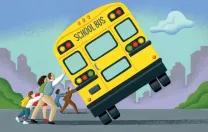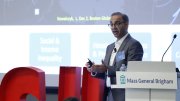Philadelphia stands as the perfect prototype of the broken urban school system that federal regulators were trying to fix. For decades the school district, beset by powerful unions, rampant cronyism, and bureaucratic sclerosis, has shown little capacity for self-improvement. The performance of its fourth-grade students on the National Assessment of Educational Progress trails those of the national average by more 20 points in both math and reading—roughly two years’ worth of learning. At the eighth-grade level, Philadelphia students are still trailing by about 15 points in both subjects. Philadelphia and Chicago have similar demographics, but Chicago leads Philadelphia by about 14 points at the fourth-grade level and 8 points at the eighth-grade level. Since 2009, Chicago’s scores have ticked upward by about 10 points in each subject at the two grade levels, while Philadelphia’s scores have hardly budged—and even slipped backward in fourth-grade reading.
The Obama administration’s stimulus package induced more stress than relief. Between 2003 and 2010, revenue available to the city’s public and charter schools increased (in inflation-adjusted dollars) from $12,000 per pupil to well over $15,000, a 25 percent increment facilitated primarily by expanded federal aid (see graph). The money was easily spent. Philadelphia’s teacher salaries rose 4 percent in 2009, 3 percent in 2010, and another 3 percent in 2012. With all those increases, the average teacher earned just short of $71,000, plus free healthcare for all family members. Teacher pensions rose by a corresponding amount, the bill to be paid by the state. The average pupil/teacher ratio declined by one student per teacher to about 16:1.
Those halcyon days ended abruptly in 2013 when the stimulus package dried up, while state and local revenues failed to make up the difference. In that year, the district received only $13,700 per student in revenue from all sources, more than a 10 percent decline from 2010. Not surprisingly, teacher unions and local officials slammed the state government for failing to fill the gap the federal government had left behind. When schools nearly failed to open on time, Philadelphia mayor Michael Nutter moaned, “It is a sad day in public service that we find children being held on the railroad tracks awaiting rescue to come from somewhere.” Clearly, school-board officials had discovered it was easier to expand than retrench.
Meanwhile, Philadelphia’s charter schools keep perking along. They receive about the same amount per pupil as district schools, though the district receives extra monies to serve its larger number of special-education students. The widely respected study by CREDO at Stanford, which takes special care to identify similar students in charter and district-school settings, found in 2015 that students in Philadelphia’s charter schools performed at a level that implied they had received the equivalent of an additional 43 days in reading and math instruction each year. Not surprisingly, charter enrollment more than doubled between 2007 and 2013 (the last year for which official data are available). That is no less than 30 percent of all public-school students in the district, an exodus from district-operated schools that shows little sign of slowing.
(For a fuller account, see John Caskey and Mark Kuperberg, “The Philadelphia School District’s Ongoing Financial Crisis,” Education Next, Fall, 2014.)










